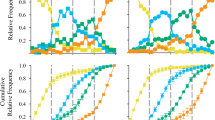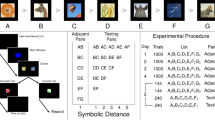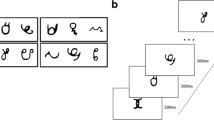Abstract
In two experiments, mice learned 24-element serial patterns. In Experiment 1, patterns either were perfectly structured or had a single violation element and were either phrased by temporal pauses or unphrased. In Experiment 2, the same violation pattern of Experiment 1 was phrased by temporal cues, visual cues, or a combination of the two. For mice, as for rats and humans in earlier studies, pattern structure predicted pattern learning difficulty and also the nature and relative frequency of errors. Mice, like rats and humans, also found a violation element especially difficult to learn and at that point in the pattern made errors consistent with the structure of the remainder of the pattern. However, in both experiments, phrasing interfered with responding correctly on the element after the phrasing cue. In a third experiment, mice were able to use temporal intervals and, to a lesser degree, visual stimuli as discriminative cues to control spatial responses in the same apparatus used in earlier studies. The results support the view that mice are sensitive to pattern organization but may have difficulty using phrasing cues in the context of serial patterns.
Similar content being viewed by others
References
ALESCIO-LAUTIER, B., SOUMIREU-MOURAT, B. (1986). Comparison oi retention and extinction of a visual discrimination as an index of forgetting in mice. Animal Learning S Behavior, 14, 197–204.
AMMASSARI-TEULE, M., CAPRIOLI, A. (1985). Spatial learning and memory, maze running strategies and cholinergic mechanisms in two inbred strains of mice. Behavioral Brain Research, 17, 9–16.
BOWER, G. H., WINZENZ, D. (1969). Group structure, coding, and memory for serial digits. Journal of Experimental Psychology Monographs, 80, Part 2, 1–17.
CAPALDI, E. J., VERRY, D. R., NAWROCKI, T. M., MILLER, D. J. (1984). Serial learning, interitem associations, phrasing cues, interference, overshadowing, chunking, memory, and extinction. Animal Learning & Behavior, 12, 7–20.
CRABBE, J. C., ALPERN, H. F. (1973). A comprehensive analysis of single-trial and criterion maze learning in three inbred strains of mice. Behavioral Biology, 9, 681–693.
FOUNTAIN, S. B. (1990). Rule abstraction, item memory, and chunking in rat serial-pattern tracking. Journal of Experimental Psychology: Animal Behavior Processes, 16, 96–105.
FOUNTAIN, S. B., ANNAU, Z. (1984). Chunking, sorting, and rule-!earning from serial patterns of brain-stimulation reward by rats. Animal Learning & Behavior, 12, 265–274.
FOUNTAIN, S. B., EVENSEN, J. C., HULSE, S. H. (1983). Formai structure and pattern length in serial pattern learning by rats. Animal Learning & Behavior, 11, 186–192.
FOUNTAIN, S. B., HENNE, D. R., HULSE, S. H. (1984). Phrasing cues and hierarchical organization in serial pattern learning by rats. Journal of Experimental Psychology: Animal Behavior Processes, 10, 30–45.
FOUNTAIN, S. B., HULSE, S. H. (1981). Extrapolation of serial stimulus patterns by rats. Animal Learning & Behavior, 9, 381–384.
FOUNTAIN, S. B., ROWAN, J. D. (1995a). Sensitivity to violations of “run” and “trill” structures in rat serial-pattern learning. Journal of Experimental Psychology: Animal Behavior Processes, 21, 78–81.
FOUNTAIN, S. B., ROWAN, J. D. (1995b). Coding of hierarchical versus linear pattern structure in rats and humans. Journal of Experimental Psychology: Animal Behavior Processes, 21(3), 187–202.
FOUNTAIN, S. B., WALLACE, D. G., CARMAN, H. M., ROWAN, J. D., STEMPOWSKI, N. K., BENSON, A. M. (1998). Discrimination learning, rule teaming, and hippocampal versus nonhippocampal processes in sequential behavior. In S. B. Fountain, M. D. Bunsey, J. H. Danks., & M. K. McBeath (Eds.), Animal cognition and sequential behavior: Behavioral, biological, and computational perspectives. Submitted for publication.
HULSE, S. H. (1978). Cognitive structure and serial pattern learning by animals. In S. H. Hulse, H. Fowler., & W. K. Honig (Eds.), Cognitive processes in animal behavior (pp. 311–340). Hillsdale, NJ: Erlbaum.
HULSE, S. H., DORSKY, N. P. (1977). Structural complexity as a determinant of serial pattern learning. Learning and Motivation, 8, 488–506.
HULSE, S. H., DORSKY, N. R (1979). Serial pattern learning by rats: Transfer of a formally defined stimulus relationship and the significance of nonreinforcement. Animal Learning & Behavior, 7, 211-220.
JAFFARD, R. DUBOIS, M., GALEY, D. (1981). Memory of a choice direction in a T maze as measured by spontaneous alternation in mice; Effects of intertriai interval and reward. Behavioural Processes, 6, 11–21.
KESNER, R. P., NOVAK, J. M. (1982). Serial position curve in rats: Role of the dorsal hippocampus. Science, 218, 173–175.
KESSLER, J., MARKOWITSCH, H. J., GULDIN, W., RIESS, R., PRITEL, M., STREICHER, M., KERRIOU, M. (1980). Comparative analysis of delayed alternation learning in cats, mice, and guinea pigs. Animal Learning & Behavior, 8, 457–464.
LASHLEY, K. S. (1951). The problem of serial order in behavior. In L. A. Jeffress (Ed.), Cerebral mechanisms in behavior, (pp. 112–146). New York: Wiley.
LEJEUNE, H., WEARDEN, J. H. (1991). The comparative psychology of fixed-interval responding: Some quantitative analyses. Learning and Motivation, 22, 84–111.
MILLER, G. A. (1956). The magical number seven, plus or minus two: Some limits on our capacity for processing information. Psychological Review, 63, 81–97.
NAGY, Z. M., SANDMANN, M. (1973). Development of learning and memory of T-maze training in neonatal mice. Journal of Comparative Physiological Psychology, 83(1), 19–26.
OLTON, D. S., SHAPIRO, M. L., & HULSE, S. H. (1984). Working memory and serial patterns. In H. L. Roitblat, T. G. Bever., & H. S. Terrace (Eds.), Animal cognition (pp. 171–182). Hillsdale, NJ: Lawrence Erlbaum Associates.
PAGE, S. C., HULSE, S. H., CYNX, J. (1989). Relative pitch perception in the European starling (Sturnus vulgaris): Further evidence for an elusive phenomenon. Journal of Experimental Psychology: Animal Behavior Processes, 15, 137–146.
RESTLE, F. (1972). Serial patterns: The role of phrasing. Journal of Experimental Psychology 92, 385–390.
RESTLE, F. (1976), Structural ambiguity in serial pattern learning. Cognitive Psychology, 8, 357–381.
RESTLE, E., & BROWN, E. R. (1970). Serial pattern learning. Journal of Experimental Psychology, 83, 120–125.
RESTLE, E., & BURNSIDE, B. L. (1972). Tracking of serial patterns. Journal of Experimental Psychology, 95, 299–307.
REUTER, J. H., CHUNG, H. S. (1988). The contribution of the rewarded and non-rewarded stimulus in visual discrimination learning in mice. Behavioral Brain Research, 27, 269–272.
ROULLET, P., LASSALLE, J. M., JEGAT, R. (1993). A study of behavioral and sensorial bases of radial maze learning in mice. Behavioral and Neural Biology, 59(3), 173–179.
SANDS, S. E., & WRIGHT, A. A. (1980). Primate memory: Retention of serial list items by a rhesus monkey. Science, 209, 938–940.
SIMON, H. A., KOTOVSKY, K. (1963). Human acquisition of concepts for sequential patterns. Psychological Review, 70, 534–546.
TERRACE, H. S. (1987). Chunking by a pigeon in a serial learning task. Nature, 325, 149–151.
TERRACE, H. S. (1991). Chunking during serial learning by a pigeon: I. Basic evidence. Journal of Experimental Psychology: Animal Behavior Processes, 17, 81–93.
TERRACE, H. S., CHEN, S. (1991a). Chunking during serial learning by a pigeon: II. Integrity of a chunk on a new list. Journal of Experimental Psychology: Animal Behavior Processes, 17, 94–106
TERRACE, H. S., CHEN, S. (1991b). Chunking during serial learning by a pigeon: Iii. What are the necessary conditions for establishing a chunk? Journal of Experimental Psychology: Animal Behavior Processes, 17, 107–118.
UPCHURCH, M., WEHNER, J. M. (1988). Differences between inbred strains of mice in Morris water maze performance. Behavior Genetics, 18(1), 55–68.
WARREN, J. M. (1982). Age and brightness discrimination learning by C57bl76j mice. Developmental Psychobiology, 15(1), 9–12.
WERBOFF, J., ANDERSON, A. (1967). Spatial and visual performance and learning in mice. Perceptual and Motor Skills, 24, 67–72.
WERBOFF, J., ANDERSON, A. (1977). Age and motivation in mice: Performance and learning in a spatial water maze. Perceptual and Motor Skills, 44, 1239–1248.
WRIGHT, A. A., SANTIAGO, H. C., SANDS, S. F., KENDRICK, D. F., COOK, R. G. (1985). Memory processing of serial lists by pigeons, monkeys, and people. Science, 229, 287–289.
Author information
Authors and Affiliations
Corresponding author
Additional information
This work was supported in part by the National Institute of Mental Health Grant MH48402.
Special thanks go to Douglas M. Kilne, Department of Biological Sciences, Kent Stale University, for providing the mice that served as subjects in all the reported studies. We also thank Jason Machan and Nicolette Warren for assistance in collecting data.
Rights and permissions
About this article
Cite this article
Fountain, S.B., Krauchunas, S.M. & Rowan, J.D. Serial-Pattern Learning in Mice: Pattern Structure and Phrasing. Psychol Rec 49, 173–192 (1999). https://doi.org/10.1007/BF03395315
Published:
Issue Date:
DOI: https://doi.org/10.1007/BF03395315




